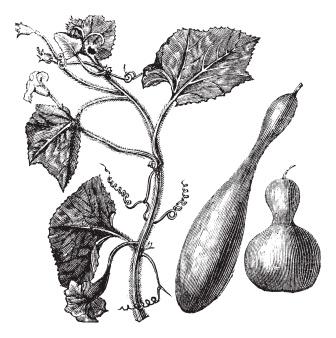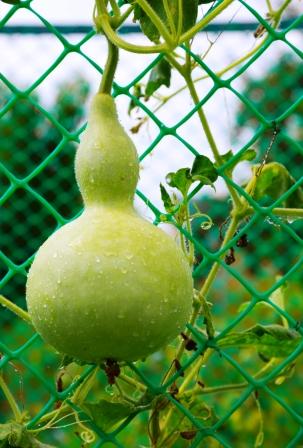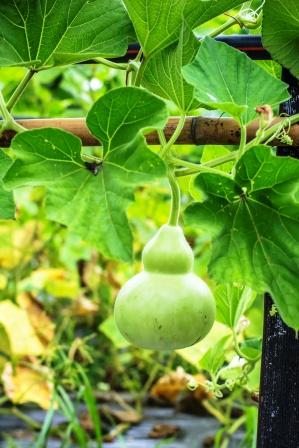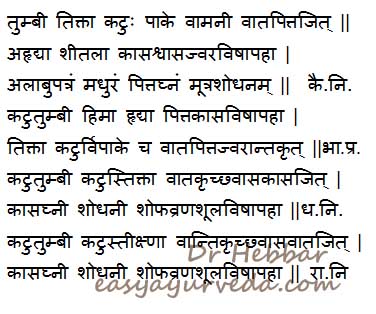Bottle Gourd Uses, Home Remedies, Side Effects, Research
Bottle gourd or calabash is a climber which is described in ayurveda for the treatment of jaundice, diabetes, localized swelling and skin diseases. It is also used to induce purgation and emesis (Panchakarma treatment). It is known by the terms Lauki, Louki in Hindi.
Table of Contents
Introduction
Latin name- Lagenaria siceraria Standl.
Family- Cucurbitaceae (Kosataki kula)
Lagenaria leucantha (equated with sweet bottle gourd) and Lagenaria vulgaris are the previously used Latin names for the herb katutumbi.

Bottle Gourd Recipes, Remedies
Several home remedies are also in practice derived out of Bottle gourd and few of them are explained here below-
Burning sensation of eyes, chest
1. Raw bottle gourd pieces in burning sensation of head, eyes and chest:
Bottle gourd is washed and its outer skin is peeled.
10-15 small pieces (5-10 gram sized) are made and this is consumed one after the other (which is tasty like any raw vegetable) without adding spices and salt.
This reduces all kind of burning complaints including burning of urine as well as during defecation. Person feels cooling effect for the next day itself.
Conjunctivitis
2. Bottle gourd fresh juice in conjunctivitis:
2-3 ml of fresh juice is obtained out of sweet bottle gourd and used to instill to both the eyes. This relieves gritting and burning of the eyes caused during conjunctivitis.
Purulent discharge also controlled soon by this.
If the patient hesitates to instill to the eyes fine paste of this can be applied over the closed eyes. This also contributes significant, similar benefit.
Liver and gall bladder diseases
3. Bottle gourd soup in liver and gall bladder disaesses:
Bottle gourd pieces are made and cooked by adding small quantity of water. (preferably salt is not added; if any body feels difficulty to take without salt or least amount of salt or jaggery, as per ones requirement can be added).
If necessary little pepper can be added.
This soup is consumed or taken along with boiled rice or Chapati in cases like biliary colic, jaundice, bile stones, biliary head ache etc.
Fatigue, lethargy
4. Bottle gourd kheer/ payasam in fatigue, lethargy etc:
Sliced or grated bottle gourd is cooked well and milk is added (coconut milk can also be added). Further by adding jaggery or sugar candy it is stirred well till complete dissolution. If necessary this is garnished with saffron or flavored with cardamom.
This relieves tiredness and is a good rejuvinator and sexual vigor enhancer (both in men and women).
Read related: Feeling tired all the time? 10 Reasons and solutions
Acid peptic disorders
5. Bottle gourd flower recipe in Acid peptic disorders:
Sweet bottle gourd gives white colored flowers.3-4 flowers are taken and fried a little, with ghee. This is churned well with buttermilk and 1-2 pinch of pepper. Further by adding little salt this is served along with food/rice.
Or else this can be used to drink also.
This acts as a regulator of the digestive fire. This helps to reduce tastelessness, head ache, nausea, acid peptic disorders, acidic regurgitation etc.
The flower can be used to make chutney also (wherte little grated coconut or coconut powder can be added while grinding).
Taste enhancing
6. Bottle gourd tender seed fry as taste enhancer:
Tender bottle gourd is taken and cut into pieces. The seeds (soft) are collected and fried with little ghee (or sesame oil). Little pepper or salt are also added.
This is taken out of the fire and taken while it is luke warm
This is very tasty and it enhances taste in the food stuffs. Children especially like this kind of healthy vegetable seed fry.
Note: Bottle gourd peel chutney is also having the same properties.
Bitter variety of bottle gourd also available and one should be careful while using such a variety as it is purgative and emetic as well.
Click to consult Dr MS Krishnamurthy MD(Ayu), PhD

Properties, part used, dosage
Lauki, calabash medicinal properties:
Rasa (Taste) – Tikta (Bitter)
Guna (Qualities) – Laghu (Light), Ruksha (Dry)
Veerya (Potency) – Sheeta (Cold)
Vipaka- Katu (Undergoes Pungent taste after digestion)
Karma (Action) – Balances Vata and Pitta
Vamaka (Induces emesis), Ahrdya (Not good for the heart muscles), Vishagna (reduces poisonous effect)
Pharmacological action – Emetic, Purgative, Anti – inflammatory
Part used- Root, Leaf, Fruit
Dosage- Fresh juice 10-20 ml.
Qualities
Bottle gourd – Calabash qualities:
Madhura rasa (sweet taste)
Laghu- snigdha- sheeta- manda- mridu (light, unctous, cold, thich and soft)
Madhura vipaka (sweet biological transformation)
Sheeta veerya (cold potency)
It is appreciated as Vatapittahara; excess intake of this may provoke Kapha.
Read related: Bottle Gourd Uses, Home Remedies, Side Effects, Research
Functions
Srotoshodhaka (clears the body channels)
Yakrit uttejaka (hepatic tissue regenerator),
Pittasaraka(cholegogue),
Pittaprashamana (coolant),
Malabhedaka (laxative),
Malavardhaka (bowel quantity enhancer) etc.
So, this remains as a vegetable of choice in the conditions like-
Obstructive jaundice (ruddhapatha kamala),
Gouty arthritis(vatarakta),
Aruchi (anorexia),
Shirashoola (head ache),
Grahani (mal absorption) etc.
Chemical constituents
Lagenaria siceraria chemical constituents:
The bitter fruit of bottle gourd contains 0.013% of cucurbitacin B and aglycones. The fruit juice contains beta- glucosidase. The leaves and root of the plant contain cucurbitacin B. The seed contains avenasterol and codisterol. Palmitic acid, Stearic acid, Iinobic & obic acids are found in seed oil.
Uses of katutumbi
- Nasal drops are indicated of katutumbi leaves to treat jaundice and sinusitis.
- The fresh juice of Lagenaria siceraria is used for mouth wash and gargling to treat dental caries.
- The medicated oil prepared from the leaves and root of the katumbi plant is used for external application to treat skin diseases, localized swelling and wounds.
- The fruit, leaves and root of Lagenaria siceraria is used to induce emesis and purgation as part of panchakarma procedures in Ayurveda.
- The paste of the leaves of the plant is applied over the affected area due to insect bites along with pain and itching sensation.
- The decoction of the leaves and fruit is given 20-25 ml in a divided dose to treat infections and skin diseases due to blood impurity.
- The decoction of the fruit and leaves in a dose of 15-20 ml is given in the empty stomach to treat intestinal worms.
- The sweet variety of the fruit is used as a vegetable in different dishes.

Sanskrit verse

Uses, indications
Ayurvedic uses of Lauki – Bottle gourd
Vamani – induces vomiting
Vatapittajit – Balances Vata and Pitta
Ahrudya – not good for heart
Sheetala – coolant
Indicated in –
Kasa – cough, cold
Shwasa – asthma and chronic respiratory disorders
Jvara – fever
Visha – Toxic conditions, poisoning, insect bite etc.
Shopha – inflammation
Vrana – Ulcers, wounds
Shoola – abdominal colic pain
Leaves of bottlegourd –
Madhura – sweet
Pittaghna – Pittahara – useful in Pitta imbalance disorders such as gastritis, burning sensation, etc.
Mutrashodhana – cleanses urinary bladder
Side effects
Side effects of Iksvaku:
Contraindicated persons to consume katutumbi (Bitter variety): People suffering from cardiac diseases should avoid taking katutumbi or its formulations as katutumbi cause emesis and purgation, during which it can exert more pressure on the cardiac muscles. Children, old age people and pregnant women also should avoid consuming kautumbi.
Read related: 6 Bottle Gourd Remedies For Gall Bladder, Conjunctivitis, Fatigue
Bottle gourd is used in a method of bloodletting therapy called Alabu Avacharana.
Interaction with medicines, supplements
Can this be used while taking Homeopathic medicine?
Yes. This product does not react with homeopathic medicine.
Can this medicine be continued while taking supplements like multivitamin tablets, Omega 3 fatty acids etc?
Yes. Generally, this product goes well with most dietary supplements. However, if you are taking more than one product per day, please consult your doctor for an opinion.
With western
medicines
Seek your
doctor’s advice if you are taking this product along with other western
(allopathic / modern) medicines. Some Ayurvedic herbs can interact with modern
medicine.
If both Ayurvedic and allopathic medicines are advised together, then it is
best to take Allopathic medicine first, wait for 30 minutes and then take the
Ayurvedic medicine.
Ayurvedic medicines
Ayurvedic medicines containing Lauki as ingredient:
Maha vishagarbha Taila: It is a medicated ayurvedic oil used for external application in the treatment of sciatica, pain in major joints of the body, vata dosha related stiffness and pain in the body.
In Charaka Samhita Kalpasthana, Acharya Charaka has mentioned some of the formulations, which can be prepared to induce emesis and purgation.
Yogas of Charaka samhita
Totally 45 yogas are mentioned
Substitute
Laenaria leucantha
Lagenaria vulgaris
Research
Research articles on katutumbi (Bottle gourd)
Multiple health benefits: The plant is used as a medicine as diuretic activity. Further it is used to treat pain, ulcer, fever, and respiratory disorders. In some countries it is traditionally used to treat diabetes.
Natural guard against diseases: The fruit of the plant helps in treating constipation, premature graying of hair, insomnia, increased blood pressure. It also helps in improving the memory, reducing weight and treating ulcers.
The effect of the petroleum ether extract of seeds of Lagenaria siceraria was evaluated in experimental models of pain and inflammation. The seed extract at 200 & 400 mg/ml showed significant decrease in acetic acid writhing in mice with a maximum of 32 % at 200 mg/ml & 58 % at 400 mg/ml. The anti-inflammatory effects observed with the extract were comparable to that of standard. There was significant anti-ulcerogenic property.
Anti- depressant activity: LS fruit slices were dried and extracted with methanol in Soxhlet apparatus for 5-6 h. Adult Wistar albino rats were subjected to a behavior despair test. Imipramine was used as a reference standard drug.
Anti- diabetic activity: Lagenaria siceraria induced significant reduction in blood glucose and increasing of serum insulin, our data indicate that the level of glucose in the animals that were subjected with alloxan was 210 mg/dl comparing with normal 70 mg/dl, the level of blood glucose in diabetic group when subjected with Lagenaria siceraria extract decreased to 89-106.5 mg/dl. These findings suggest that LSPE and LSSE treatment exerts therapeutic protective effect in diabetes by preserving pancreatic cell integrity and significant activity extract, which supports traditional usage of the plant to prevent diabetic complications.
Calabash, white-flowered, cooked, boiled, drained, without salt
Taste – bitter
Properties – light, dry
Potency – cold
After digestion taste transformation ( Vipaka ) – pungent
Effect on Doshas
Vata balancing
Pitta balancing
Kapha neutral (due to reduced heaviness as a result of cooking)
Calabash , white-flowered, cooked, boiled, drained, with salt
Taste – bitter
Properties – light, dry
Potency – not very cold (salt is hot)
After digestion taste transformation ( Vipaka ) – pungent
Effect on Doshas
Vata balancing
Pitta nourishing (salt is Pittakara)
Kapha neutral (due to reduced heaviness as a result of cooking)
Kanpyo, (dried gourd strips)
Prepared with dried shavings of calabash.
Taste – bitter
Properties – heavy (due to increased nutrient concentration when dried), dry
Potency – cold
After digestion taste transformation ( Vipaka ) – pungent
Effect on Doshas
Vata balancing
Pitta balancing
Kapha increasing (due to increased nutrient concentration)
Author: Dr.B.K.Prashanth M.D (Ayu), Ph.D
E mail: [email protected]
Consult Dr Prashanth by email
Sthanika karma (Systemic Acton)
Externally – Being Astringent in taste it has styptic action. Leaf paste can be used for external application in Splenomegaly. Decoction of the leaves can be used for wound cleaning and for sits bath in prolapsed rectal cases. It is also beneficial in Dental caries for gargling. Dries leaf powder can be used for sprinkling in wounds to arrest bleeding. Leaves are also used for fumigation in Hemorrhoids and in wounds.
Internally
Digestive system – Bark is indicated in Diarrhea. Decoction is especially indicated in splenomegaly
Circulatory System – Indicated in bleeding disorders, Root decoction is indicated in skin diseases and in edema.
Reproductive system – Indicated in leukorrhea, Menorrhagia etc. Leaf decoction can be used for uttara basti for the same purpose. powder and leaf juice is beneficial in premature ejaculation.
Vernacular names
Names in different languages:
Hindi name- Titalouki, Kadavi louki, Lauki
English name- Bottle gourd, Long melon, Calabash, white-flowered gourd, Bitter calbash gourd
Bengali Name- Titlaou, Ladu
Gujarati Name- Kadavi tumbadi, Dudhi, Tumada
Kannada Name- Sorekai, Sorekayi
Telugu name- Sorekaya, Sorakkaya
Manipuri name – Khongdrum
Marathi name – Dudhi
Tamil name – Surakkai
Malayalam name – Pechura
Urdu name – Lauki
Sanskrit synonyms
Synonyms of Louki in Sanskrit:
Pinda phala- Fruit is spherical in shape
Tikta beeja, Tiktalabu- The fruit is bitter in taste
Mahaphala- Fruit grows to a big size
Tiktabija – Seeds are bitter in taste
Katutumbi – Because of its bitter taste it destroy kapha and pitta
Ikshvaku, Tumbi, Lamba, Katutumbi, Rajaputri, Tumbika,
Katutumbi is more popularly known as Ikshvaku in Ayurvedic pharmacopeia. It is a climber which is abundantly found all over India in temperate climate. The fruit is bitter in taste and used for medicinal purposes. Another variety of this plant, in which the fruit is little sweet, is cultivated for its vegetable use. It is popularly known as ‘Louki’ in Hindi language and used for many culinary purposes.
Bottle gourd – Louki is a familiar vegetable, used by in many countries including India. Its reference and utility is found from the Samhita period itself (1-3 Century BC).This is named as Alabu in Ayurveda.
The name bottle gourd is given probably due to its shape of a bottle. But today we get varieties of bottle gourds too (different size and shaped bottle is also available!).
Classical categorization
Classical categorization of Ikshvaku / Katutumbi:
Charaka samhita- Vamana and Phalini
Sushruta samhita- Urdhwabaga hara
Bhavaprakasha- Shaka varga
Dhanvantari Nighantu- Guduchyadi varga
Kaiyyadeva Nighantu- Oushadhi varga
Raja Nighantu- Guduchyadi varga
Scientific classification
Scientific classification of Bottle gourd
Kingdom: Plantae
Order: Cucurbitales
Family: Cucurbitaceae
Genus: Lagenaria
Species: L. siceraria
Types
Types of Alabu depending on the shape :
Deerga alabu – Elongated
Vrintha alabu – Spherical.











17 comments
Dr. Hitesh Acharya
good information…. but here is one question for u sir… Lauki in hindi and bottle gourd in English described in the article is usually long light green colored available in market and used as vegitable .. both are same? and bottle gourd known in Gujarati language as ” Dudhi “
Dr J V Hebbar MD(Ayu)Author
Dear Dr Hitesh, Lauki and Bottlegourd are one and the same, as per my info. Please see here – https://www.google.co.in/webhp?sourceid=chrome-instant&ion=1&espv=2&ie=UTF-8#q=bottle+gourd+in+Hindia
Gujarathi name updated. Thanks.
Ravi
Can a glassful(250ml) of lauki juice(cold pressed) be had in the morning on empty stomach ?
Dr J V Hebbar MD(Ayu)Author
That looks a bit excess. 100 ml per day is good enough.
Kamal
Can 100 ml of the juice be taken for people who have vata-pitta imbalance?
Dr J V Hebbar MD(Ayu)Author
Better to start with just 50 ml per day.
S M V Prasad
Sir, How to improve the platelets count& Present count is 125000-
Rajani
Sir, My son always gets cough and cold. I think due to low immunity. Can consuming lauki in some form, juice/soup or just simple vegetable, help him?
Raja Srinivasan
I have a question. Why do some traditional Brahmin Families avoid eating Louki and associate it with snake venom?
Dr J V Hebbar MD(Ayu)Author
May be, for that particular locality and climate, lauki is not conducive.
ABHISHEK PATIL
Sir , you have mentioned ahradya while explaining rasa, guna karma and in research part it is told as cardiotonic
Both are contradictory statements!!
mehal
some said lauki is vayavi, means Vayu producing but here it said it is vata balancing . can you please clear my confusion.
Dr J V Hebbar MD(Ayu)Author
As per textbook Bhavaprakasha, it balances Vata and Pitta Doshas.
Laxmi Dangi
Sir,I need bitter bottle gourd
Where can I get it from ?
Would you ,please ,tell me about any shop center or in your knolege foemwhere I can have it?
Or if it is your one is to make available?
Sir please I am in the great need of it
Dr J V Hebbar MD(Ayu)Author
Hi, bottle gourd is often sold in supermarkets and vegetable markets. Please search locally.
Dipul
Sir, my confusion is same as ABHISHEK PATIL
08/10/2020 at 12:33 am
Sir , you have mentioned ahradya while explaining rasa, guna karma and in research part it is told as cardiotonic
Both are contradictory statement.
What should I do, my mother is heart patient?
Dr J V Hebbar MD(Ayu)Author
Sorry for the confusion. There are animal experimental research works that have proven cardio-protective action. If the animal experimental study is taken further and a research institute conducts a clinical trial to analyse its function on heart, we can conclusively say that it actually is conducive for heart.